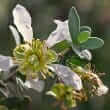Background
- Jojoba (Simmondsia chinensis) is a shrub native to deserts in Arizona, California and Mexico and is also found in some arid African countries. The oil (or liquid wax) in jojoba seeds contains extremely long (C36-C46) straight chain fatty acids in the form of wax esters, as opposed to triglycerides. It is this structure that allows it to be easily refined for use in cosmetics and as a carrier oil for fragrances. Jojoba meal, remaining after oil extraction, is rich in protein. In Japan, jojoba oil (wax) is used as a food additive.
- Jojoba oil is used most commonly as a carrier oil for topical application or aromatherapy. At this time, there are no high-quality human trials available supporting the efficacy of jojoba oil for any indication. Potential effects of jojoba oil include anti-inflammatory, cholesterol-reduction and mosquito-repellant effects.
References
Natural Standard developed the above evidence-based information based on a thorough systematic review of the available scientific articles. For comprehensive information about alternative and complementary therapies on the professional level, go to . Selected references are listed below.
- Bahgat MM, Maghraby AS, Heiba ME, et al. Synthesis of new 4-oxo-2-thioxo-1,2,3,4-tetrahydropyrimidine derivatives with an incorporated thiazolidinone moiety and testing their possible serine protease and cercarial elastase inhibitory effects with a possible prospective to block penetration of Schistosoma mansoni cercariae into the mice skin. Arch Pharm Res 2005;28(9):1002-1012.
View Abstract - Bahgat M, Shalaby NM, Ruppel A, et al. Humoral and cellular immune responses induced in mice by purified iridoid mixture that inhibits penetration of Schistosoma mansoni cercariae upon topical treatment of mice tails. J Egypt.Soc Parasitol. 2005;35(2):597-613.
View Abstract - Boozer CN, Herron AJ. Simmondsin for weight loss in rats. Int J Obes.(Lond) 2-7-2006.
View Abstract - Di Berardino L, Di Berardino F, Castelli A, et al. A case of contact dermatitis from jojoba. Contact Dermatitis 2006;55(1):57-58.
View Abstract - El Laithy HM, El Shaboury KM. The development of Cutina lipogels and gel microemulsion for topical administration of fluconazole. AAPS.PharmSciTech. 2002;3(4):E35.
View Abstract - Habashy RR, Abdel-Naim AB, Khalifa AE, et al. Anti-inflammatory effects of jojoba liquid wax in experimental models. Pharmacol Res 2005;51(2):95-105.
View Abstract - Hsu S. Green tea and the skin. J Am Acad.Dermatol 2005;52(6):1049-1059.
View Abstract - Kalscheuer R, Stoveken T, Luftmann H, et al. Neutral lipid biosynthesis in engineered Escherichia coli: jojoba oil-like wax esters and fatty acid butyl esters. Appl Environ.Microbiol. 2006;72(2):1373-1379.
View Abstract - Kim MJ, Nam ES, Paik SI. [The effects of aromatherapy on pain, depression, and life satisfaction of arthritis patients]. Taehan Kanho.Hakhoe.Chi 2005;35(1):186-194.
View Abstract - Kohara H, Miyauchi T, Suehiro Y, et al. Combined modality treatment of aromatherapy, footsoak, and reflexology relieves fatigue in patients with cancer. J Palliat.Med 2004;7(6):791-796.
View Abstract - Lee SY. [The effect of lavender aromatherapy on cognitive function, emotion, and aggressive behavior of elderly with dementia]. Taehan Kanho.Hakhoe.Chi 2005;35(2):303-312.
View Abstract - Leon F, Van Boven M, de Witte P, et al. Isolation and identification of molecular species of phosphatidylcholine and lysophosphatidylcholine from jojoba seed meal (Simmondsia chinensis). J Agric.Food Chem 3-10-2004;52(5):1207-1211.
View Abstract - Lievens S, Flo G, Decuypere E, et al. Simmondsin: effects on meal patterns and choice behavior in rats. Physiol Behav. 2003;78(4-5):669-677.
View Abstract - Tada A, Jin ZL, Sugimoto N, et al. Analysis of the constituents in jojoba wax used as a food additive by LC/MS/MS. Shokuhin Eiseigaku Zasshi 2005;46(5):198-204.
View Abstract - Van Boven M, Laga M, Leonard S, et al. Mechanism of simmondsin decomposition during sodium hydroxide treatment. J Agric.Food Chem 2-26-2003;51(5):1260-1264.
View Abstract







